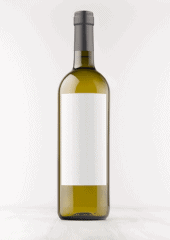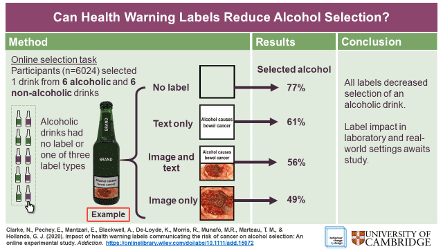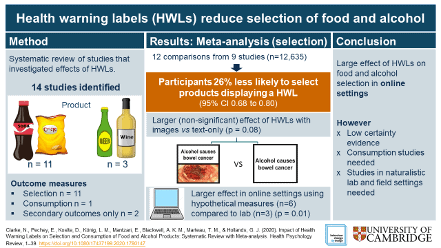
Today, in most countries, if you go to the shop to buy a packet of cigarettes it’s likely you’ll be faced with a gruesome image on the packaging. These images are not pleasant, but the harms that smoking causes are not pleasant either. Pictorial (or ‘graphic’) health warning labels on tobacco packaging were implemented in an attempt (amongst others) to reduce smoking-related harms and have been shown to change smoking behaviours.
Drinking too much alcohol also carries health harms. For example, excess alcohol consumption increases the risk of cardiovascular disease, liver cirrhosis and seven types of cancers – including cancers that are commonly known as being related to alcohol, like liver cancer, but also cancers that are less commonly known, including bowel and breast cancer. Despite these health harms, alcohol packaging is not required to display the same health warning labels as tobacco. While there are differences between smoking and drinking – there are no low-risk guidelines for smoking, whereas it’s murkier for drinking – there is a solid consensus amongst public health bodies and researchers that current alcohol labelling must be improved. One possibility would be to introduce tobacco-style warning labels.
However, before such labels are implemented, we first need evidence of whether or not they can be effective. There’s some research that finds that tobacco-style health warning labels on alcohol can reduce the rate of consumption and change drinking intentions, but on the whole there’s limited evidence from large-scale studies looking at selection and consumption behaviours.
We carried out a study to investigate the impact of alcohol health warning labels – that communicated the risk of specific cancers – in an online setting. Over 6,000 participants completed a selection task, where they viewed a selection of alcoholic (beer and wine) and non-alcoholic drinks (including alcohol free and soft drinks), and selected one that they wanted to drink. Depending on the condition that the participant was randomised to, the alcoholic drinks displayed either no label, or one of three types of health warning labels – text-only, image-and-text or image-only. We found that when the alcoholic drinks displayed any of the three health warning labels, alcohol selection was lower than when no label was displayed. The largest decrease was for the health warning labels with graphic images. These findings are promising, but we can’t draw conclusions about real behaviour, as the study was conducted online and the task was hypothetical.
 |
We have also conducted a systematic review to look at the existing evidence on health warning labels on alcohol and food products. Overall, we found that health warning labels reduced selection of labelled products by 26%, but only three studies looked at alcohol (one of these was our study discussed above). We also found that there may be a larger effect in these online hypothetical settings compared to laboratory settings that use real products. This suggests again that we should be cautious when drawing conclusions from online studies. Importantly, we really need more studies from real-world environments.
 |
A recently conducted field study in Canada (which has also been covered in two IAS blog posts) aimed to do this, but was met with major challenges from the alcohol industry which resulted in text-only cancer health warning labels being withdrawn from the trial. Despite these challenges, this study still showed promising findings; over a year period sales were reduced by 6% when alcohol displayed improved labels – which included the cancer labels and also labels that communicated drinking guidelines. This suggests health warning labels could show promise in a real-world setting, but running these types of studies to generate conclusive evidence is extremely challenging. However, it’s important to bear in mind that tobacco health warning labels faced similar challenges and are now implemented in 118 countries worldwide – so it is possible.
Health warning labels have potential, and are one possible option for improving current alcohol labels. Before we imagine a world where our wine bottle warns us of cancer risks, we need more large-scale real-world studies that look at whether or not they can change drinking behaviour.
References
Clarke, N., Pechey, E., Kosīte, D., König, L. M., Mantzari, E., Blackwell, A. K. M., Marteau, T. M., & Hollands, G. J. (2020). Impact of Health Warning Labels on Selection and Consumption of Food and Alcohol Products: Systematic Review with Meta-analysis. Health Psychology Review. https://doi.org/10.1080/17437199.2020.1780147
Clarke, N., Pechey, E., Mantzari, E., Blackwell, A. K. M., De‐loyde, K., Morris, R. W., Munafò, M. R., Marteau, T. M., & Hollands, G. J. (2020). Impact of health warning labels communicating the risk of cancer on alcohol selection: An online experimental study. Addiction. https://doi.org/10.1111/add.15072
Written by Natasha Clarke and Gareth Hollands from the Behaviour Change by Design programme at the University of Cambridge.
Natasha Clarke (@Clarke_NC1) is a research associate in the Behaviour and Health Research Unit at the University of Cambridge. Gareth Hollands (@GJHollands) is a researcher at the University of Cambridge whose research focuses on developing and evaluating interventions that change aspects of physical environments to change health-related behaviours.
All IAS Blogposts are published with the permission of the author. The views expressed are solely the author’s own and do not necessarily represent the views of the Institute of Alcohol Studies.
